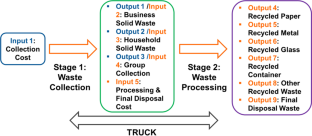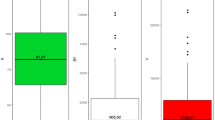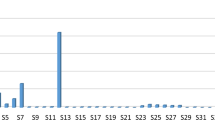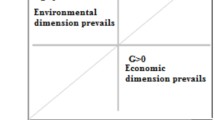Abstract
Recycling is an essential part of circular economy. This research constructs a two-stage waste generation and recycling activity model, selecting Japan as a case study object to explore its recycling efficiencies through this model. Japan’s regional recycling efficiency is assessed in two stages: waste collection as stage 1 and the treatment and process of the recycling waste as stage 2. We adopt a network data envelopment analysis (DEA) model by Tone and Tsutsui (2009) to measure the recycling efficiencies of 47 administrative regions in Japan, taking in account multiple inputs and outputs from 2013 to 2017. The empirical results indicate that the efficiency of stage one (waste collection) performs worse than that of stage two (treatment and process of recyclables). The metropolitan regions consistently outperform the rural regions, because the metropolitan regions perform better in stage one (waste collection). Local governments should improve the waste collection by co-working with local communities and volunteer groups. All regions perform relatively more efficiently in stage 2 (waste processing).



Similar content being viewed by others
Data Availability
Available based on reasonable requests.
References
Allwood JM (2014) Squaring the circular economy: the role of recycling within a hierarchy of material management strategies. Handbook of recycling: state-of-the-art for practitioners, analysts, and scientists. Elsevier, pp 445–477
Li D, Wang MQ, Lee C (2020) The waste treatment and recycling efficiency of industrial waste processing based on two-stage data envelopment analysis with undesirable inputs. J Clean Prod 242:118279. https://doi.org/10.1016/j.jclepro.2019.118279
Sun J, Li G, Wang Z (2019) Technology heterogeneity and efficiency of China’s circular economic systems: a game meta-frontier DEA approach. Resour Conserv Recycl 146:337–347. https://doi.org/10.1016/j.resconrec.2019.03.046
Tsai TH (2008) The impact of social capital on regional waste recycling. Sustain Dev 16(1):44–55. https://doi.org/10.1002/sd.326
Nakano M, Managi S (2012) Waste generations and efficiency measures in Japan. Environ Econ Policy Stud 14:327–339. https://doi.org/10.1007/s10018-012-0038-2
Ministry of the Environment Japan (2014) History and current state of waste management in Japan. Tokyo. Retrieved from https://www.env.go.jp/en/recycle/smcs/attach/hcswm.pdf. Accessed 18 Nov 2020
Bongers A, Casas P (2022) The circular economy and the optimal recycling rate: a macroeconomic approach. Ecol Econ 199:107504. https://doi.org/10.1016/j.ecolecon.2022.107504
Aarikka-Stenroos L, Kokko M, Pohls EL (2023) Catalyzing the circular economy of critical resources in a national system: case study on drivers, barriers, and actors in nutrient recycling. J Clean Prod 397:136380. https://doi.org/10.1016/j.jclepro.2023.136380
Forastero ÁG (2023) Resources, conservation & recycling advances circular economy in Andalusia: a review of public and non-governmental initiatives. J Clean Prod 397:136380. https://doi.org/10.1016/j.rcradv.2023.200133
Shah MU, Rezai R (2023) Public-sector participation in the circular economy: a stakeholder relationship analysis of economic and social factors of the recycling system. J Clean Prod 400:136700. https://doi.org/10.1016/j.jclepro.2023.136700
Lahcen B, Eyckmans J, Rousseau S, Dams Y, Brusselaers J (2022) Modelling the circular economy: introducing a supply chain equilibrium approach. Ecol Econ 197:107451. https://doi.org/10.1016/j.ecolecon.2022.107451
Tripathy A, Bhuyan A, Padhy RK, Mangla SK, Roopak R (2023) Drivers of lithium-ion batteries recycling industry toward circular economy in industry 4.0. Comput Ind Eng 179:109157
Wang D, Ponce P, Zhang Y, Ponce K, Tanveer M (2022) The future of industry 4.0 and the circular economy in Chinese supply chain: in the era of post-COVID-19 pandemic. Oper Manag Res 15:342–356. https://doi.org/10.1007/s12063-021-00220-0
Ichinose D, Yamamoto M, Yoshida Y (2013) Productive efficiency of public and private solid waste logistics and its implications for waste management policy. IATSS Res 36:98–105. https://doi.org/10.1016/j.iatssr.2013.01.002
Callan SJ, Thomas JM (2001) Economies of scale and scope: a cost analysis of municipal solid waste services. J Land Public Util E 77(4):548–560. https://doi.org/10.2307/3146940
Bohm RA, Folz DH, Kinnaman TC, Podolsky MJ (2010) The costs of municipal waste and recycling programs. Resour Conserv Recycl 54:864–871. https://doi.org/10.1016/j.resconrec.2010.01.005
Hu JL, Chang TP, Kao CH (2008) Four-in-one waste recycling performance of local governments in Taiwan. J Resour Energy Dev 5(2):83–94. https://doi.org/10.3233/RED-120052
Marques RC, da Cruz NF, Carvalho P (2012) Assessing and exploring (in)efficiency in Portuguese recycling systems using non-parametric methods. Resour Conserv Recycl 67:34–43. https://doi.org/10.1016/j.resconrec.2012.07.005
Rogge N, De Jaeger S (2012) Evaluating the efficiency of municipalities in collecting and processing municipal solid waste: a shared input DEA-model. Waste Manag 32(10):1968–1978. https://doi.org/10.1016/j.wasman.2012.05.021
Crociata A, Mattoscio N (2015) Output-orientated data envelopment analysis for measuring recycling efficiency: an application at Italian regional level. Environ Educ Res 22(4):551–570. https://doi.org/10.1080/13504622.2015.1015494
Chang DS, Liu W, Yeh LT (2013) Incorporating the learning effect into data envelopment analysis to measure MSW recycling performance. Eur J Oper Res 229(2):496–504. https://doi.org/10.1016/j.ejor.2013.01.026
Wu H, Shi Y, **a Q, Zhu W (2014) Effectiveness of the policy of circular economy in China: a DEA-based analysis for the period of 11th five-year-plan. Resour Conserv Recycl 83:163–175. https://doi.org/10.1016/j.resconrec.2013.10.003
Honma S, Hu JL (2021) Cost efficiency of recycling and waste disposal in Japan. J Clean Prod 284:125274. https://doi.org/10.1016/j.jclepro.2020.125274
Gennitsaris S, Sagani A, Sofianopoulou S, Dedoussis V (2023) Integrated LCA and DEA approach for circular economy-driven performance evaluation of wind turbine end-of-life treatment options. Appl Energy 339:120951. https://doi.org/10.1016/j.apenergy.2023.120951
Djordjević B, Maitra R, Ghosh B (2023) Environmental efficiency assessment of Dublin Port using two-stage non-radial DEA model. Marit Transp Res 4:100078. https://doi.org/10.1016/j.martra.2022.100078
Yang H, Zhang X, Liu B, Huang Y (2023) Evaluation of green low-carbon innovation development efficiency: an improved two-stage non-cooperative DEA model. J Clean Prod 400:136662. https://doi.org/10.1016/j.jclepro.2023.136662
Tone K, Tsutsui M (2009) Network DEA: a slacks-based measure approach. Eur J Oper Res 197(1):243–252. https://doi.org/10.1016/j.ejor.2008.05.027
Tone K (2001) A slacks-based measure of super-efficiency in data envelopment analysis. Eur J Oper Res 143(1):32–41. https://doi.org/10.1016/S0377-2217(01)00324-1
Seiford LM, Zhu J (1999) Profitability and marketability of the Top 55 US commercial banks. Manage Sci 45:1270–1288. https://doi.org/10.1287/mnsc.45.9.1270
Peteraf MA (1993) The cornerstones of competitive advantage: a resource-based view. Strateg Manag J 14(3):179–191. https://doi.org/10.1002/smj.4250140303
Honma S, Hu JL (2018) A meta-stochastic frontier analysis for energy efficiency of regions in Japan. J Econ Struct 7:21. https://doi.org/10.1186/s40008-018-0119-x
Chifari R, Lo Piano S, Matsumoto S, Tasaki T (2017) Does recyclable separation reduce the cost of municipal waste management in Japan? Waste Manage 60:32–41. https://doi.org/10.1016/j.wasman.2017.01.015
Mann HB, Whitney DR (1947) On a test of whether one of two random variables is stochastically larger than the other. Ann Math Statist 18(1):50–60. https://doi.org/10.1214/aoms/1177730491
Iyer ES, Kashyap RK (2007) Consumer recycling: role of incentives, information, and social class. J Consum Behav 6(1):32–47. https://doi.org/10.1002/cb.206
Shah A, Yu Z, Tanveer M, Ali W, Saleem AR (2023) Effect of product assortment, internet of things, order fulfillment, green on purchase intention through the mediating role of shop** assistance. J Adv Manuf Syst 22(1):123–147. https://doi.org/10.1142/S0219686723500075
Lu LC, Chiu SY, Chiu YH, Chang TH (2022) Three-stage circular efficiency evaluation of agricultural food production, food consumption, and food waste recycling in EU countries. J Clean Prod 343:130870. https://doi.org/10.1016/j.jclepro.2022.130870
Zhang L, Du X, Chiu YH, Pang Q, Wang X, Yu Q (2022) Measuring industrial operational efficiency and factor analysis: a dynamic series-parallel recycling DEA model. Sci Total Environ 851:158. https://doi.org/10.1016/j.scitotenv.2022.158084
Yamamoto M, Kinnaman TC (2022) Is incineration repressing recycling? J Environ Econ Manage 111:102593. https://doi.org/10.1016/j.jeem.2021.102593
Acknowledgements
We thank an editor and two anonymous referees of this journal, seminar participants at annual meetings of the Taiwan Economic Association and Asian Association of Environmental and Resource Economics for their valuable comments.
Funding
The first two authors gratefully acknowledge financial support from Taiwan’s Ministry of Science and Technology (MOST108-2410-H-009–039) and the Japan Society for the Promotion of Science (JSPS) KAKENHI Grant Number 19K01659, respectively.
Author information
Authors and Affiliations
Contributions
Conceptualization, J.L.H. and S.H.; methodology, J.L.H.; software, J.L.H. and T.M.C.; validation, J.L.H. and S.H.; formal analysis, J.L.H, S.H., and T.M.C.; investigation, T.M.C. and M.Y.C.; resources, J.L.H.; data curation, T.M.C.; writing—original draft preparation, T.M.C.; writing—review and editing, J.L.H. and S.H.; visualization, S.H. and T.M.C.; supervision, J-L.H. and S.H.; and project administration, J.L.H. All authors have read and agreed to the published version of the manuscript.
Corresponding author
Ethics declarations
Ethics Approval and Consent to Participate
N/A.
Consent for Publication
N/A.
Competing Interests
The authors declare no competing interests.
Rights and permissions
Springer Nature or its licensor (e.g. a society or other partner) holds exclusive rights to this article under a publishing agreement with the author(s) or other rightsholder(s); author self-archiving of the accepted manuscript version of this article is solely governed by the terms of such publishing agreement and applicable law.
About this article
Cite this article
Hu, JL., Honma, S. & Chang, TM. Recycling Efficiencies in Japan’s Administrative Regions: Findings from Network Data Envelopment Analysis. Circ.Econ.Sust. 4, 1–21 (2024). https://doi.org/10.1007/s43615-023-00274-1
Received:
Accepted:
Published:
Issue Date:
DOI: https://doi.org/10.1007/s43615-023-00274-1




